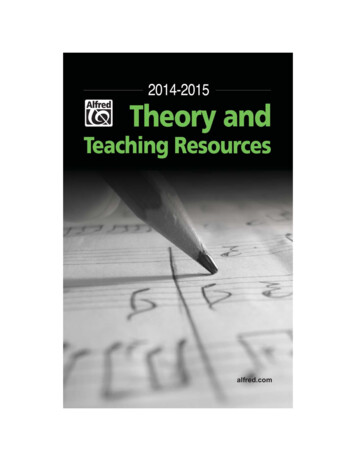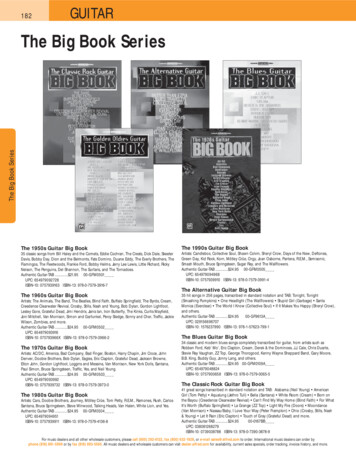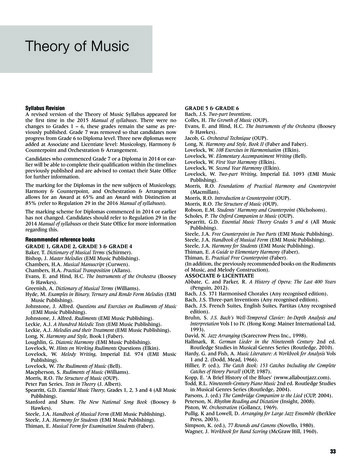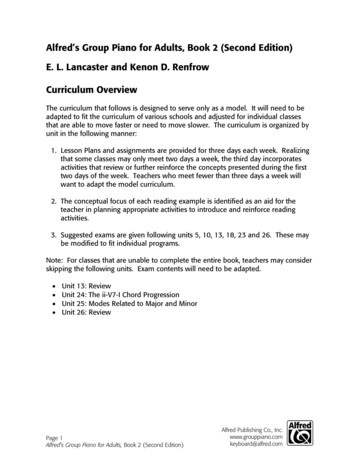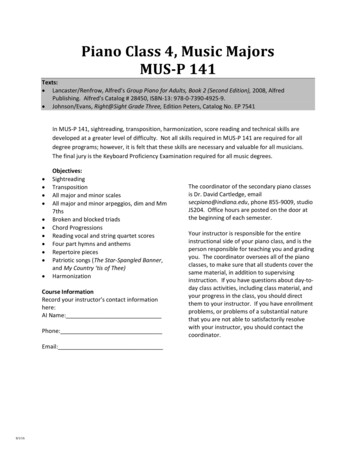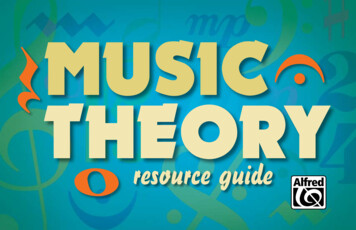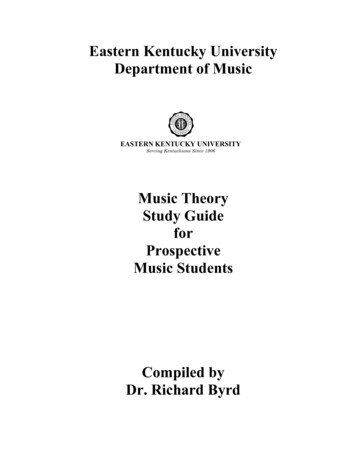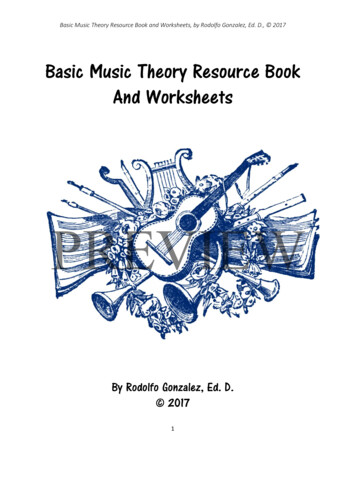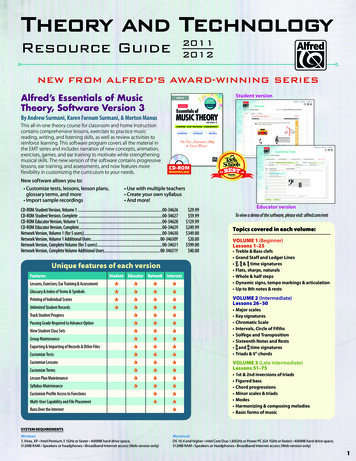
Transcription
Theory and Technology20112012Resource GuideNEW FROM ALFRED’S AWARD-WINNING SERIESAlfred’s Essentials of MusicTheory, Software Version 3Student versionBy Andrew Surmani, Karen Farnum Surmani, & Morton ManusThis all-in-one theory course for classroom and home instructioncontains comprehensive lessons, exercises to practice musicreading, writing, and listening skills, as well as review activities toreinforce learning. This software program covers all the material inthe EMT series and includes narration of new concepts, animation,exercises, games, and ear training to motivate while strengtheningmusical skills. The new version of the software contains progressivelessons, ear training, and assessments, and now features moreflexibility in customizing the curriculum to your needs.CD-ROMWINDOWS/MACNew software allows you to: Customize tests, lessons, lesson plans,glossary terms, and more Import sample recordings Use with multiple teachers Create your own syllabus And more!CD-ROM Student Version, Volume 1.00-34626CD-ROM Student Version, Complete .00-34627CD-ROM Educator Version, Volume 1.00-34628CD-ROM Educator Version, Complete.00-34629Network Version, Volume 1 (for 5 users).00-34630Network Version, Volume 1 Additional Users.00-34630YNetwork Version, Complete Volume (for 5 users).00-34631Network Version, Complete Volume Additional Users.00-34631YUnique features of each versionFeaturesStudent Educator Network InternetLessons, Exercises, Ear Training & AssessmentGlossary & Index of Terms & SymbolsPrinting of Individual ScoresUnlimited Student RecordsTrack Student ProgressPassing Grade Required to Advance OptionView Student Class SetsGroup MaintenanceExporting & Importing of Records & Other FilesCustomize TestsCustomize LessonsCustomize TermsLesson Plan MaintenanceSyllabus MaintenanceCustomize Profile Access to FunctionsMulti-User Capability and File PlacementRuns Over the Internet 29.99 59.99 129.99 249.99 349.00 20.00 599.00 40.00Educator versionTo view a demo of the software, please visit: alfred.com/emtTopics covered in each volume:VOLUME 1 (Beginner)Lessons 1–25 Treble & Bass clefs Grand Staff and Ledger Lines2 3 4 4 , 4 & 4 time signatures Flats, sharps, naturals Whole & half steps Dynamic signs, tempo markings & articulation Up to 8th notes & restsVOLUME 2 (Intermediate)Lessons 26–50 Major scalesKey signaturesChromatic ScaleIntervals, Circle of FifthsSolfège and TranspositionSixteenth Notes and Rests368 and 8 time signaturesTriads & V7 chordsVOLUME 3 (Late intermediate)Lessons 51–75 st & 2nd inversions of triads1Figured bassChord progressionsMinor scales & triadsModes Harmonizing & composing melodiesBasic forms of musicSYSTEM REQUIREMENTSWindows7, Vista, XP Intel Pentium 3 1GHz or faster 400MB hard drive space,512MB RAM Speakers or headphones Broadband Internet access (Web version only)MacintoshOS 10.4 and higher Intel Core Duo 1.83GHz or Power PC (G4 1GHz or faster) 400MB hard drive space,512MB RAM Speakers or headphones Broadband Internet access (Web version only)1
Alfred’s Essentials of Music TheoryBy Andrew Surmani, Karen Farnum Surmani & Morton ManusAlfred’s Essentials of Music Theory is a series of three 40-page books that introduces musical conceptsthrough concise lessons followed by short exercises. Included in each of the 18 units is a page of eartraining and a page of review. For string students, an Alto clef edition is also available. For additionalresource material, Books 1–3 also have a corresponding Teacher’s Activity Kit, each with 30 reproducibleactivity pages plus six tests. The entire series covers 48 classical compositions from 33 differentcomposers, as well as 72 folk songs from 22 different world cultures. The musical examples includesymphonies, marches, operas, oratorios, concertos, and piano literature.The ear training examples included on two audio CDs are performed by acoustic instruments (piano,strings, woodwinds, and brass).Book 1. 00-17231Book 2. 00-17232Book 3. 00-17233Complete Book. 00-17234Complete Book & 2 Ear Training CDs. 00-16486Viola/Alto Clef Book 1. 00-18580Viola/Alto Clef Book 2. 00-18581Viola/Alto Clef Book 3. 00-18582Viola/Alto Clef Complete Book. 00-18583 6.50 6.50 6.50 12.95 31.50 6.50 6.50 6.50 19.95Teacher’s Answer Key. 00-17256Teacher’s Answer Key & 2 Ear Training CDs. 00-17261Ear Training CD 1 (for Books 1 & 2). 00-17252Ear Training CD 2 (for Book 3). 00-17253Ear Training CDs 1 & 2 (for Books 1–3). 00-17254Self-Study Course(Complete Book, 2 CDs & Answers). 00-23194 19.95 37.95 10.95 10.95 18.95 39.95To view a demo of the software, please visit: alfred.com/emtBingo Games & Flash CardsReinforce concepts and facts through games! With the Double Bingogames, two separate, color-coded games are on each side of everyplayer card. Play both games separately, then together—SIX games inall. Three editions are available: Rhythm, Note Naming & Key Signature.The exciting Flash Card sets include 48 note naming, rhythm or keysignature cards, with exercises on both sides, for a total of 96 examples.It is organized into four progressive sets (6 for key signatures) and maybe used with any beginning music theory course.Bingo GamesFlash CardsRhythm. 00-19479 19.95Rhythm. 00-19396 9.99Note Naming. 00-19481 19.95Note Naming. 00-20320 9.95Key Signature. 00-24448 19.95Key Signature. 00-24447 9.95REPRODUCIBLESHEETS!Teacher’s Activity KitsTired of creating your own tests and activities? Thesereproducible sheets will save you time and effort as theyreinforce theoretical concepts. Each kit has 30 reproducibleactivities plus six tests. Use in conjunction with Alfred’sEssentials of Music Theory, or with any other theory course.Activity Kit, Book 1.00-19380 19.95Activity Kit, Book 2.00-20373 19.95Activity Kit, Book 3.00-26321 19.95Activity Kit, Complete.00-26327 49.95Alfred’s Essentials of Jazz TheoryBy Shelton G. BergLearn, practice, and test your knowledge of jazz! Book 1 introduces swing feel, major anddominant seventh and ninth chords, dominant function, bebop dominant scale, 12-bar bluesand more. Book 2 explores minor chords, ii-V-I progressions, diminished and augmented idioms,altered dominants, upper structures and other jazz essentials. Book 3 covers melodic soloingand sequence, minor 11th and sus chords, jazz minor scale and mode. Learn the essentials of jazz music through concise lessons Practice jazz music reading and writing skills in the exercises Test knowledge with a review that completes each unit CDs: Improve listening and ear training skills with the recorded examplesBook 1 with CD.00-20806Book 2 with CD.00-20808Book 3 with CD.00-20810Complete with 3 CDs.00-20812Teacher’s Answer Key with 3 CDs.00-22008Self-Study Course(Complete Book, 2 CDs & Answers).00-26265 12.95 12.95 12.95 34.95 39.99 34.99Great for students who have completed one year of traditional music theory.Use after Alfred’s Essentials of Music Theory, Book 3.2EarTrainingCDsAvailableCDIncludedwithkEach Boo
Alfred’s Interactive MusicianPitch Training Rhythm Sight-ReadingImmerse yourself and your students aged 10 and up in a fun and challenging interactive environment fordeveloping musicianship! Featuring three unique sections, Pitch Training, Sight-Reading and Rhythm, Alfred’sInteractive Musician is designed to enhance recognition of intervals, chords and scales, improve ability to sightread, and prepare for various types of rhythms. The self-paced program responds instantly to the user’s actions,helping to quickly identify strengths and weaknesses. With multiple levels to choose from and the abilityto customize levels, Alfred’s Interactive Musician gives complete control over the content and difficulty of theprogram. With the Educator and Network versions, teachers have the ability to create assessment tests that arescored electronically and have immediate access to student progress. Students work at their own pace, whilethe teacher sets up guidelines for the student to follow. Drills are randomized, so exercises may be played overand over without duplicating material. For Windows or Macintosh.Student Version CD-ROM (Win/Mac).00-23135 39.95Educator Version CD-ROM (Win/Mac).00-23136 99.95*Network Version CD-ROM (Win/Mac).00-23137 249.95CD-ROMWINDOWS/MAC* The Network Version includes licenses for 5 simultaneous users (not including the instructor). Additional user licenses can be purchased for 30.00 each (item 00-23137Y—available throughretailers only). Customers should purchase user licenses for the maximum number of students that will be accessing the program at one time.RhythmPitch TrainingSight-ReadingTheory Games for Windows/Macintosh(Version 2.0)By Willard A. Palmer, Morton Manus, Amanda Vick Lethco, and Rob WrenCD-ROMWINDOWS/MACThis upgraded software boasts new and improved games, a higher level of organizationwithin each subject, improved record-keeping and testing features as well as colorfulgraphics. Different aspects of music theory, such as note recognition, intervals, rhythmand musical terms correspond to each lesson in Alfred’s Basic Piano Library Lesson Books.Windows and Mac compatible.Levels 1A, 1B, 2 CD-ROM (Early Elementary / Late Elementary).00-14432 19.95Levels 3, 4, 5 CD-ROM (Early Intermediate / Intermediate).00-14433 19.95Counting Game: Collect apples from the treeby adding the missing note values.Carnival Fun!: Identify the harmonic intervalso the dart pops the balloon.Name That Key: Identify the piano key onwhich the ladybug is sitting.Cross the River!: Help the frog cross theroad safely by identifying musical symbols.Note Name Race / Chord Name Race:Correctly identify the notes or chords to finishthe obstacle course.Under the Sea!: Make the correct notes“bubble” to the surface to form scales.3
Morton Subotnick:Creating Music SeriesNow children can experience music at the most basic level, before ever picking up aninstrument or learning to read! Morton Subotnick’s series of interactive music gamesfacilitates experimenting with the fundamentals of pitch, rhythm and sounds of variousinstruments and styles of music. Children learn what it means to play a high or low note, softor loud and fast or slow, with lovable characters and detailed explanations to guide themalong the way!How does the composer explain how he wants the music played? How would you playsome of the world’s famous classical pieces? Learn about tempo, dynamics and expressionwith games, performance videos and a glossary of music terms! Then, relate the conceptsto written music by seeing the appropriate expression marks on the sheet music. Finally,create your own interpretations of classical music and see it performed by three loveablecharacters! Ages 8 and up.Playing MusicCD-ROM.00-30537 39.95Hearing MusicCD-ROM.00-30539 39.95Making MusicCD-ROM.00-30541 39.95Making More MusicCD-ROM.00-30881 39.95World of Music (Beginner)Beginner CD-ROM.00-30531 39.95World of Music (Intermediate)Intermediate CD-ROM.00-30533 39.95CD-ROMWINDOWS/MACSee a product demo atwww.creatingmusic.com/demoTheory for Young MusiciansBy Nathaniel Gunod, Susan Mazer, and Carla UlbrichThis series is a fun way to begin to learn music. Books 1 and 2 contain theory lessons, eartraining lessons and worksheets. Students from ages 8 to 12 in their first year of lessons willreinforce their music reading skills and gain a better understanding of the building blocks ofmusic. This thorough, easy-to-use method includes theory lessons, ear training (with CDs forbooks 1 and 2) and worksheets.Book 1Book & CD.00-18514CD.00-18515 17.95 10.00Book 2Book & CD.00-18517CD.00-18518 17.95 10.00Theory for Young Musicians, NotespellerBook.00-18512 5.95Composition for Young MusiciansBy Jennifer WilsonBook & CD.00-22913Practical TheoryBy Sandy FeldsteinA three-volume theory text designed to be used with or without the correlated software discs.Perfect for classroom use. Students learn new concepts in class with the workbook, then mayreview and reinforce those concepts in a computer lab. A combination text and workbook in threevolumes. All areas of music theory are covered in a concise and practical manner and each levelcontains 28 lessons.Volume 1.00-2280 5.99Volume 2.00-2281 5.95Volume 3.00-2282 5.95Complete.00-1998 12.954 17.95
Materials of Western MusicBy William G. Andrews and Molly SclaterThis series was created to afford serious students of Western music the opportunity ofrelating the component parts of the music they have played, that is, melody, harmony,rhythm, phrasing and structure. The harmonic vocabulary has been introduced ina logical order using melodic lines and examples from a wide variety of composers,periods, styles and media. Companion volumes encourage creative discussion of themusic examples, more time for sight reading and more time for keyboard harmony.Part 1.00-V1417 39.95Part 2.00-V1418 39.95Part 3.00-V1426 89.95Companion to the Harmonicand Structural Analysis of theMaterials of Western MusicBy William G. AndrewsProvides a complete analysis of the Materials of Western Music.Part 1.00-V1431 16.95Part 2.00-V1432 12.95Alfred’s Essential SeriesEssentials of Music NotationBy Tom Gerou and Linda LuskThis pocket-sized dictionary presents current and correct notation practices in an easy-to-use format.Generously illustrated and concise, this book is essential to any musician looking for a handy referencefor the correct notation of music. A most welcome and beneficial source for every musician, whetherusing a pencil or a computer.Book.00-32756 11.95Pocket Size Book.00-16638 6.95Essentials of OrchestrationBy Dave Black and Tom GerouAny teacher, student or professional musician, whether a composer, orchestrator, arranger, performeror enthusiast will find this thoroughly comprehensive dictionary full of the most needed informationon over 150 instruments. Designed for quick and easy reference, includes those much-neededinstrument ranges, general characteristics, tone quality descriptions, technical pitfalls, useful scoringtips and much more!Book.00-32757 11.95Pocket Size Book.00-17894 6.95Essential Dictionary of ComposersBy L.C. HarnsbergerThis Handy Guide functions as an easy-to-use historical-reference book, both educational and fun!It provides important information on composers, spanning from the middle ages to contemporary/pop. Every entry contains basic facts such as dates and historical periods of music as well as additionalitems of interest and importance.Handy Guide.00-16642 4.95Essential Dictionary of MusicBy L.C. HarnsbergerA comprehensive collection of composers, theory and definitions, this Handy Guide provides a broadrange of information, from basic principles of theory and biographies of composers to pronunciationsof foreign terms and ranges of instruments and voices. The concise, easy-to-use, spiral-bound volumecovers every major aspect of music.Handy Guide.00-16756 10.99Pocket Size Book.00-16636 5.95Essential Dictionary of Music TheoryBy L.C. HarnsbergerPacks a wealth of information into our “user-friendly” Handy Guide format. Covering virtually everyaspect of music theory, the volume includes everything from scales and modes to comprehensiveranges of woodwinds, brass, stringed instruments (with open-string pitches) and voices. Also includestablature and guitar notation, and features written and sounding ranges for transposing instruments.Handy Guide.00-16643 5.955
Complete Idiot’s Guide SeriesThe Complete Idiot’s Guide Music DictionaryMusic explained in the simplest termsBy Dr. Stanford FelixWritten in clear, concise language, The Complete Idiot’s Guide Music Dictionary spans the gamut of musicalknowledge, making it indispensable to any musician. Covering various terms, theories, instruments, importantworks, musicians, and composers, music professor Stanford Felix explains it all in a way that even the novicecan comprehend. This is the only music dictionary geared toward the beginner.Book. 74-1592579976 16.95The Complete Idiot’s Guide to Music CompositionBy Michael MillerThis book shows you how to compose with chords-first and melody-first, methods for developing simplemelodic motifs and themes into longer compositions, tips for creating interesting chord progressions,and much more. Also covers traditional and contemporary compositional techniques, selecting the rightinstruments and voicings, orchestrating and arranging, and creating complete scores.Book. 74-1592574033 18.95The Complete Idiot’s Guide to Music HistoryBy Michael MillerMusic history is a required course for all music students. Unfortunately, the typical music history book is dryand academic, focusing on rote memorization of important composers and works. This leads many to thinkthat the topic is boring, but best selling author Michael Miller proves that isn’t so. This guide makes musichistory interesting and fun, for both music students and older music lovers.* Covers more than Western “classical” music—also includes non-Western music and uniquely American formssuch as jazz* More than just names and dates—puts musical developments in context with key historical eventsBook. 74-1592577514 18.95Classroom ResourcesReady to Read Music: Sequential Lessons inMusic Reading ReadinessBy Jay AlthouseDon’t ask your students to read music until they are “ready to read music.” This 100% reproducible book ispacked with four sequential units of eight lessons each, all designed to prepare your students to read music.Most of the lessons are followed by a page of exercises, ideal for student assessment. And, as a bonus, thereare page after page of large, reproducible music symbols.great for bulletin boards and flash card learning.Book.00-21835 24.9560 Music Quizzes for Theory and ReadingOne-page Reproducible Tests to Evaluate Student Musical SkillsBy Jay AlthouseJust what the titles says: 60 one-page quizzes on a variety of subjects related to beginning music theory andreading. Includes sections on “The Basics,” “Rhythm,” “Note Names,” “Key Signatures,” “Musical Symbols andTerms,” “Time Signatures,” “Keyboard Identification,” and “Musical Puzzles.” Perfect for student assessment.Recommended for grades 3 and up. 100% reproducible.Book.00-27144 24.956
Technology ResourcesIntegrating Technology with Music InstructionUsing standard technology teaching tools to aid student learningand teach essential music skillsBy Greg Foreman and Kyle PaceA comprehensive guide to implementing technology within the music classroom, Integrating Technology withMusic Instruction offers practical strategies for utilizing technology to increase student learning, motivation andengagement and provide opportunities for essential music skills to be effectively taught and retained. Teachers willalso learn how to reduce administrative obligations and explore professional growth opportunities. IncorporatesMENC’s National Standards for Music Education.Book.00-30889 14.95Mr. Zig’s Literacy, Music & Technology ConnectionBy Zig WajlerAn outstanding resource for K-12 teachers seeking to integrate technology and the arts. Learn the process ofcreating, composing, recording, and producing a song. Includes a CD “Loop Library” and reproducible pages.Incorporates MENC’s National Standards for Music Education.Book & CD.00-31434 24.95Alfred’s Music Tech SeriesBy Floyd Richmond, Tom Rudolph, Lee Whitmore, and Stefani LangolComposing Music with NotationBook & Data CD.00-25565 16.95Playing KeyboardBook & Audio CD.00-25564 16.95Sequencing and Music ProductionBook & CD-ROM.00-25567 16.95Teacher’s ManualBook & CD-ROM.00-25566 49.95Alfred’s Pro Audio SeriesPractical Step-by-Step Training DVDsfor Creating Professional RecordingsBeginning Logic 8 & 9DVD.00-33628 19.95Beginning Cubase 5DVD.00-33631 19.95Beginning Sonar 8DVD.00-33633 19.95Beginning Pro Tools LE 8DVD.00-33635 19.95Alfred’s Pro Audio Series:Beginning GarageBand ‘09DVD.00-33637 19.957
Incorporate Technology into your Classroom withRevolutionary Methods for MusiciansRobert SHELDON Bob PHILLIPS Peter BOONSHAFT Dave BLACKSound Innovations for Concert Band and Sound Innovations forString Orchestra are two revolutionary new methods that combine timetested educational concepts, input from thousands of teachers, advancesin modern technology, and solid pedagogy that follows state and nationalmusic education standards. The methods are available in two versions:STANDARD EDITION and the customizable DIRECTOR’S CHOICE EDITION.Ability to customize withDirector’s Choice EditionInstrument-specific DVD master classesEvery line of musicin mp3 formatAvailable in SmartMusicwith the first 100 lines freeYOUR METHOD, YOUR WAYOur revolutionary technology allows you to customize your own method to fit your unique classroom!Select the pedagogy(Band: starting concert pitch, starting note value.String: starting pitch sequence, starting note value,arco/pizzicato technique.)Sound HistoryTIME LINE OF MUSIC 700Romantic1820–19001800Twentieth Century1900–present1900MUSIC OF THE TWENTIETH CENTURYMusic written in the Twentieth Century is quite varied. The early years include Impressionist music, whichuses a soft harmonic approach to music, reflecting the work of the Impressionist painters such as Renoir.The new harmonies and scales used led to the more complex and less traditional music that followed.Some composers wrote in the traditional forms of the Baroque and Classical eras but used differentharmonies. Other composers experimented by writing music in totally new ways. A new type of musiccalled serial music was developed in which all twelve notes in the scale must be used before any can berepeated. Electronic music came into being. Famous Twentieth Century composers are Aaron Copland,Igor Stravinsky, Béla Bartók, Ralph Vaughn Williams, Scott Joplin, Maurice Ravel, George Gershwin, DukeEllington, Leonard Bernstein and the later work of John Philip Sousa.FEATURED COMPOSERAaron Copland (1900–1990) was born in New York and oftenincorporated American folk styles into his music. He made use ofpercussive orchestration, changing meter, poly-rhythms, poly-chordsand tone rows. Copland wrote music for the concert hall, the theater,ballet and films.SUGGESTED LISTENINGPersonalize the cover“Hoedown” from Rodeo, CopelandStars and Stripes Forever, SousaThe Entertainer, JoplinThe Rite of Spring, StravinskyConcerto for Orchestra, BartókBoléro, RavelSOUND FACTS1905 Albert Einstein writes his paper on the theory of relativity.1919 Martin Luther King, Jr., American civil rights leader, is born.1918 World War I began.1941 World War II began.Substitute tunes and genres1881 Pablo Picasso, Spanish artist, is born.1912 The Titanic sinks.1919 Pierre-Auguste Renoir, French Impressionist artist, died.SOUND DISCUSSIONHas anyone you know ever talked about any of the events listed?Has anyone you know ever talked about music they listened to in the twentieth century?What were some of the types of music composed in the twentieth century?Add enrichment pagesalfred.com/soundinnovationsWO 3505 / 105158Online CommunityConnect with the SI team and educators all over the world. See exclusive content, news, and more!U(a38081*NNMSMq(v
Alfred’s Essentials of Music Theory By Andrew Surmani, Karen Farnum Surmani & Morton Manus Alfred’s Essentials of Music Theory is a series of three 40-page books that introduces musical concepts through concise lessons followed by short exercises. Included in each of the
